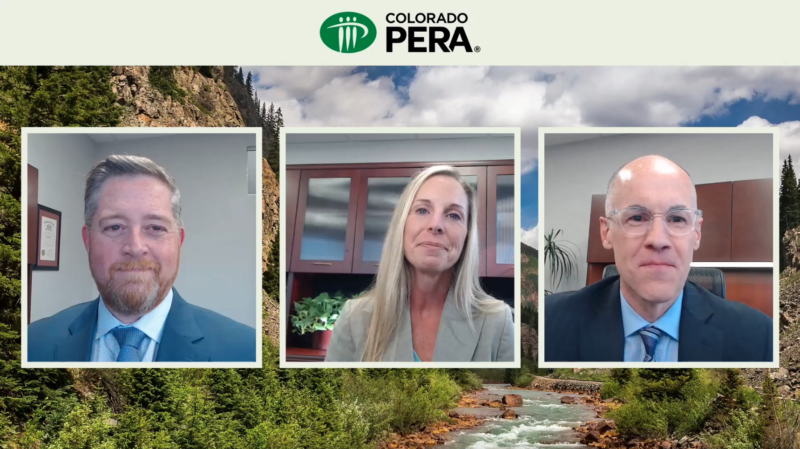PERA leaders hosted two live Town Halls on Wednesday, July 12 to provide an update on PERA and answer questions from members and retirees.
Interim Executive Director and Chief Investment Officer Amy C. McGarrity was joined by Chief Benefits Officer Patrick Lane and Chief Administrative Officer Jeremy Hill for both meetings.
They answered questions on a number of important topics, including annual benefit increases, Social Security, and PERA’s investment portfolio. Responses to some of those questions are summarized below, and full recordings of each Town Hall are available at copera.org/townhall.
Why was the previous executive director’s employment contract terminated?
“The decision was at the discretion of the PERA Board,” McGarrity said. “To reiterate, there was no criminal wrongdoing and no impact to retiree benefits. We are in the process of selecting an executive director. The first step is to select an executive search firm to assist with the recruitment of that next leader for PERA, and the Board has formed an ad hoc committee. Those ad hoc committee meetings are posted on copera.org and they’re streamed live for anyone who wishes to follow the process.”
Why aren’t annual benefit increases for retirees keeping up with inflation?
“We recognize the challenges that this inflationary environment presents. We feel it as consumers but we know it is particularly important to our retired members,” Lane said. “As you know, the Annual Increase percentage is set in statute and it is not within the purview of the PERA Board or staff to make changes to the Annual Increase…the only way that could change is if the state legislature decided to change the law, which would in effect extend PERA’s 30-year window to full funding.”
Are PERA benefits in danger due to 2022’s negative investment returns?
No, PERA benefits are not in danger. The investment portfolio is well-diversified and contains a wide array of assets so the portfolio can withstand different market environments, McGarrity said. While we were subject to the market downturn in 2022, we are also subject to positive market swings and have been able to take advantage of those markets in prior years and so far in 2023, McGarrity said.
In 2022, PERA paid $5.2 billion in retirement benefits to retirees and benefit recipients, so you can continue to count on PERA to provide retirement income throughout your life.
What is PERA doing about Social Security’s Windfall Elimination Provision (WEP) and Government Pension Offset (GPO)?
“Social Security’s WEP and GPO are provisions within federal law and are therefore outside the scope of the PERA Board and staff to influence,” Lane said. “We encourage you to contact your members of the U.S. House and Senate to be heard on this issue.”
Bills to modify or repeal WEP and GPO are frequently introduced in Congress, and PERA On The Issues monitors and reports on those activities throughout the year. Click here for our latest article on WEP/GPO reform efforts.
What is PERA doing to improve wait times to talk to Customer Service on the phone?
“We have made a number of recent changes that have cut down on wait times in the call center,” Lane said. “We implemented a new caller verification process that makes the security process faster and shortens the length of calls. And we just migrated to a new phone system just within the last few weeks that allows us to better forecast call volumes throughout the day, throughout the month and throughout the year.”
He added: “We have seen service levels increase in recent months and we look forward to providing better service going forward.”
Does PERA inform its investments by accounting for social goals, such as diversity, equity and inclusion? If so, what does that look like?
McGarrity explained that PERA’s primary goal is achieving the best risk-adjusted returns for PERA members and therefore PERA does not have any mandates related to environmental, social, or governance (ESG) or diversity, equity, and inclusion (DEI) outcomes. However, PERA staff will consider any financially relevant factors when making investment decisions.
“To the extent that a company’s long-term expected return may be influenced somehow by one of those factors in a financially material way, certainly we will consider it in our underlying due diligence of that investment and/or underwriting of that investment,” McGarrity said. “However, unless they are financially material factors or drivers of the expectations for long-term returns, they are not rising to the top of our considerations. So we are really focused on the factors that have an influence on long-term shareholder returns.”
How can members be sure PERA will be there for them when they retire?
“I think the legislature has shown its commitment through the years to keeping PERA strong and enacting reforms several times in the past decade to ensure we are on a financially sustainable path. Most recently, Senate Bill 200 (enacted in 2018) puts us on a path to full funding by 2048,” McGarrity said. “The reforms are working and we’re committed to providing reliable income in retirement that our members cannot outlive.”
PERA mobile app
Hill also mentioned PERA’s new mobile app, which is now available in the App Store for iOS devices and Google Play Store for Android devices. The app is part of PERA’s long-term goal of modernizing and improving the way it serves its membership, and it makes it easy for members and retirees to access and manage their accounts wherever they are.
These annual town halls are an important opportunity to speak directly with Colorado’s current and former public employees and we’re grateful to all who participated.
To watch full recordings of each Town Hall, visit copera.org/townhall.
Windfall elimination provisionA provision of federal law that may reduce Social Security benefit payments to retirees who receive a pension based on work during which they did not contribute to Social Security. The WEP does not apply to those with 30 or more years of substantial earnings in Social Security.Government pension offsetA provision of federal law that reduces Social Security dependent benefit payments to spouses, widows, and widowers who receive a government pension like PERA.EsgAcronym for environmental, social, and corporate governance factors that can be used when making investment decisions.Annual increaseAn adjustment to PERA retirees’ monthly benefit payments, paid in July each year. The Annual Increase amount is set in statute and can adjust up or down based on PERA’s funding progress. It is not tied to inflation.





A one hour dog and pony show to answer seven questions and take an online survey supporting MORE Town Halls… I think I know why the fund lost over 13% in market value at the end of last year… Sorry, I can’t say keep up the good work?
They are happy it means no cost of living raise next year. PERA went along with taking away our cost of living raises. Every time anyone says something about it they say nothing we can do State Statute.
Always the statute excuses. PERA must initiate and support a fiduciary action to increase the increase. Tie it to the CPI, tie it to other measures. Tie it to the CONTRACT you sold us for 3.5% in perpetuity. This continued loss is unsustainable, and unnecessary. Perform your fiduciary responsibilities.
Thumbs up for your comment. Investments are well diversified in one comment then next comment, it’s up to the legislature. WEP, is out of their hands too.
PERA did a great job not letting the state take over.
We need to know if SB23-056 and HB22-1029 have really made up for the missed contribution of 2020, or not. It seems like only 169 million out of 225 has been restored, but it was definitely made very confusing. (380-225=155+14=169). How much was it, REALLY?
The same bs we hear year after year. Look at how BIG of a raise Pera Board members got in the last 5 years and look at what you received. That will tell you where their priorities are. Will PERA ever say we did this to help our members, no, instead PERA board members put the blame elsewhere and talk about how well they are doing while their members starve.
Restore the COA, and make the COA actually make a difference for retirees. Thank you.
Wasn’t PERA funded at 105% in either 2003 or 2005? What happened that has put this on the backs of retirees?
PERA had a fire sale in years. How about those who bought cheap years shoulder responsibility for the measly 1% increase and the rest of us get increases more in tune with inflation.
Am I correct in the understanding that PERA retiree’s cannot receive more than a 1% increase per year until the year 2048 unless the fund becomes 100% funded earlier?
How can I afford an electric car, electric house, electric stove, pay my Xcel electric bill and fight global warming with a 1% increase in yearly benefit?
Hi there, the Annual Increase adjusts up or down based on PERA’s funding progress, not to exceed 2% until we reach full funding. This page provides more detail about how Annual Increases and the Automatic Adjustment Provision work: https://www.copera.org/annual-benefit-increases
Hi – I doubt PERA Board & Staff (PERA B.S.) will answer the question in your comment about the amount, if any, of future increases … So, I’ll try to share my understanding of the Automatic Adjustment Provision (AAP), that determines beneficiaries’ annual increases: The AAP can go to zero in 1/2 % increments; and is determined annually for subsequent years, but not below zero; but will only occur if “the fund” is at least at a 90% “level” (purportedly it’s currently at 105%). However, no increases based on inflation will conceivably occur until “the fund” exceeds a 120% “level” (the “level” being an assumed liability reserve ratio, whereby liabilities must equal reserves, by 2048, according to actuaries’ guesses).
The AAP is a rather subjective and complex actuarial exercise that uses the market valuation of pension fund assets based on a single day in the preceding calendar year (the last day). The complexity and subjectivity is intentional so that PERA B.S. can run the numbers by the JBC, until they hear a number they like (in other words, to make the lowest employer contribution in order to keep more money in the general revenue fund to operate government and make TABOR refunds).
The bottom line is retirees will be lucky to get a 1% annual increase after 2024 (we get 1% this year and next July). An additional caveat is it may depend on “the fund” involved, or which division you’re retired from, e.g., state, school, local government; because the AAP is calculated against each one separately, ostensibly to calculate active member and employer contribution rates; but that may also be used to impact retirees’ annual increases. Basically it’s all a continuation of the divide and conquer strategy which separates active, inactive, and retired members, along with differentiating between hire dates, as well as if one is even in the defined benefit (DB) plan verses various defined contribution (DC) offerings, plus the long standing trick of trying to pit taxpayers against public servants (as though the latter are not part of the former).
The short answer is you get 1% this July and next July, after that… well, it seems to me that PERA B.S. and the legislature want you to die by then.
On question #1, why was the previous ED contracted terminated….
sorry, you skirted the question and didn’t specifically asnwer it.
Please answer the question. Thank you.
I am very dissatisfied with the Medicare Advantage program. Medicare through PERA worked smoothly for the prior 6 years. Advantage is costly to run, has made many billing and communication errors, most facilities do not take this plan. I have had many calls to insurance and PERA. I can see non preferred providers, take the bill for monies not covered , submit that to Medicare and see what that group will pay. How is anyone, nevermind seniors, supposed to maneuver this bureaucracy?!
Yes, I did have drug coverage prior to the switch through PERA medicare.
Like others, I am frustrated with the response to the raise in retirement payments. I started with 3%, decreased to 2%, we were asked to wait out a 6 mo. period with no increase then received a 1% increase.
We were to have cost of living increases, asked to make a sacrifice for the good of the fund, and now PERA management has wiped their hands of being concerned about our benefits!
PERA was fully funded back in the 90’s but bad policy sunk that ship. First early retirement was encouraged which depleted that surplus. Next matching money to a Roth or 401k also led to the downward trend and underfunding, worst of all was allowing the employer contribution to decline from the 12% it was at to- I can’t remember-I think it went down to 10%. Hopefully if we get full funding in the future the mistakes of the past will not be repeated.
As for ESG and DEI I would hope that the folks in charge of investing are looking to the best financial outcome not WOKE BS. Remember ESG+DEI=DIE.
AS for the PERA care I don’t think it matters a whole lot what we get. The insurance is so complicated that there will be problems with just about anything we get. Keep hoping that we can manage our health without having to have some expensive treatment or medication.
Finally on the AI the average PERA benefit is around 2500 while the average SS is about 1300 so we already start from a better position so be thankful for what we have.
Jim – I thought most members had figured out that comparing Social Security to PERA benefits wasn’t just comparing apples to oranges, but a red herring! Given that PERA benefits compensate for not being covered under Social Security as well as for being paid less than private sector workers, and without private sector perks (excluding the few years of that miniscule match administered by Great West); then it’s important to remember many workers didn’t have job security (there were layoffs), no retirees had collective bargaining; and that PERA benefits actually often significantly reduces Social Security (that members may otherwise be entitled)!
Although I appreciate your spot-on observations about deficient employer contributions and ESG investing silliness (along with other political caveats on investing), your dismissive stance on the annual increase being acceptable because average PERA recipients’ benefits are higher than average Social Security payments ignores INFLATION. Why should PERA beneficiaries be “thankful for what we have,” when we earned it and if annual increases don’t keep up with inflation, so it’s effectively a BENEFIT CUT!